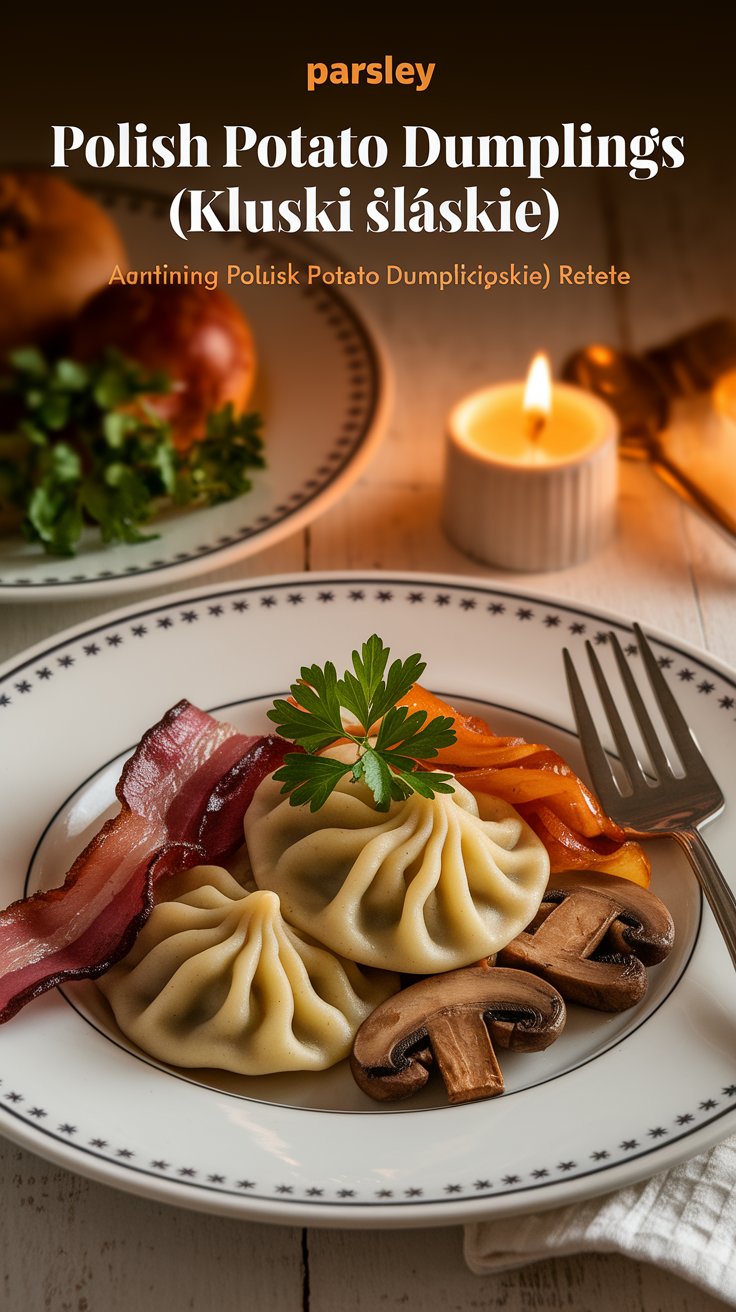Polish cuisine is a treasure chest of hearty comfort foods, passed down through generations with warmth and love. Among the many traditional dishes that hold a special place at Polish tables, Kopytka, or Polish potato dumplings, stand out as one of the most beloved. Known for their pillowy texture, rich taste, and versatility, these dumplings are a staple in many households across Poland. The name Kopytka literally translates to “little hooves”, a reference to their shape, which slightly resembles the hoofprint of a small animal.
This dish is more than just a recipe—it is a bridge to Polish heritage, family traditions, and home-style cooking. Whether served as a side dish alongside meaty gravies or enjoyed on their own with a drizzle of butter and herbs, Kopytka is both simple and deeply satisfying.
In this comprehensive guide, we’ll explore the authentic recipe for Polish potato dumplings, their cultural significance, variations, pro tips, serving ideas, storage methods, nutritional values, and answers to frequently asked questions. If you’re ready to bring a taste of Poland into your kitchen, let’s dive in.
Why You’ll Love Authentic Polish Potato Dumplings (Kopytka)
Cooking at home is not just about feeding yourself—it’s about creating an experience. Kopytka is the kind of dish that offers both comfort and creativity. Here’s why you’ll fall in love with it:
- Simple to Prepare: Made with just a handful of everyday ingredients.
- Quick Cooking Time: You can have a homemade meal on the table in about 30 minutes.
- Versatile & Adaptable: Pairs beautifully with savory sauces, meaty stews, or even sweet toppings.
- Family-Friendly: A dish both kids and adults will enjoy.
- Cultural Experience: An authentic way to explore Polish traditions in your own kitchen.
A Brief History & Cultural Significance of Kopytka
Kopytka first became popular in Poland during the 19th century when potatoes were introduced as a staple ingredient in Central and Eastern Europe. These dumplings were considered a farmer’s dish—affordable, filling, and nourishing during cold winters. Families often made them after Sunday dinners when leftover boiled potatoes were abundant.
In many households, Kopytka was a way to stretch ingredients and avoid waste. They became part of everyday Polish cuisine, commonly paired with dishes like goulash, roasted meats, or cabbage-based stews.
Interestingly, Kopytka is often compared to Italian gnocchi. While both are potato dumplings, Polish Kopytka tend to be slightly firmer, shaped into small diamond-like pieces, and more rustic in appearance. For Polish families, making Kopytka together was more than cooking—it was a family ritual that brought generations to the kitchen table.
Today, Kopytka remains a comfort food, celebrated during both ordinary weekdays and festive occasions. They symbolize resourcefulness, tradition, and togetherness.
Ingredients for Authentic Polish Potato Dumplings (Kopytka)
You’ll be pleased to know that the ingredient list is short and straightforward. Chances are, you already have everything in your pantry.
Essential Ingredients:
- 2 cups mashed potatoes (about 2 large potatoes, preferably starchy like Russets)
- 1 cup all-purpose flour (plus extra for dusting)
- 1 large egg
- ½ teaspoon salt
Optional Enhancements:
- Freshly ground black pepper – for subtle seasoning.
- Grated cheese – adds richness to the dough.
- Fresh herbs like parsley, dill, or chives – for extra aroma.
- Nutmeg – a pinch adds warmth to the flavor.
Tip: Using starchy potatoes is crucial. Waxy potatoes (like red or new potatoes) tend to make the dough too sticky and heavy.
Step-by-Step Instructions: How to Make Polish Potato Dumplings
Cooking Kopytka is a rewarding process. Each step, though simple, contributes to the dumplings’ perfect texture.
1. Prepare the Potatoes
- Peel and boil the potatoes in salted water until fork-tender.
- Drain thoroughly and allow them to cool completely. This step prevents the dough from becoming too wet.
- Mash or rice the potatoes until smooth, without lumps.
2. Make the Dough
- Place the mashed potatoes into a mixing bowl.
- Add the egg and salt, then gradually incorporate the flour.
- Mix gently until a soft dough forms. It should be pliable but not sticky. Add extra flour only if necessary—too much flour makes the dumplings dense.
3. Shape the Dumplings
- Divide the dough into quarters.
- Roll each portion into a rope about ½ inch thick.
- Cut into 1-inch diagonal pieces resembling “little hooves.”
- Optionally, press each piece lightly with a fork to create ridges for sauce adhesion.
4. Cook the Dumplings
- Bring a large pot of salted water to a boil.
- Gently drop the dumplings into the water in batches.
- Cook until they float to the surface (2–3 minutes). This signals they’re done.
- Use a slotted spoon to remove them and place on a platter.
5. Serve Immediately
- Kopytka taste best right after cooking. Serve with butter, herbs, or your favorite sauce.
Pro Tips for Perfect Kopytka
- Cool the potatoes completely before making the dough. Warm potatoes release too much moisture.
- Handle the dough gently. Over-kneading results in chewy dumplings.
- Dust lightly with flour. Prevents sticking without making them too heavy.
- Cook in small batches. This ensures even cooking and prevents clumping.
- Enhance flavors. Add grated Parmesan or sauté dumplings in butter for a golden crust.
Delicious Ways to Serve Kopytka
One of the beauties of Kopytka is their versatility. Here are some serving suggestions:
- Classic Polish Style: Drizzle with melted butter and sprinkle with fresh dill or parsley.
- With Sauces: Serve alongside mushroom cream sauce, garlic butter, or a tomato-based sauce.
- With Meats: Pair with beef goulash, roasted chicken, or pork stew for a hearty meal.
- Vegetarian Option: Toss with sautéed mushrooms, caramelized onions, or spinach.
- Sweet Version: Dust with sugar and cinnamon, then drizzle with melted butter for a dessert-style dumpling.
Variations of Kopytka
Polish families love experimenting with Kopytka. You can too!
- Cheese Kopytka: Add cottage cheese or farmer’s cheese for creamier dumplings.
- Herbed Kopytka: Mix in dill, parsley, or thyme for freshness.
- Gluten-Free Kopytka: Use potato starch or a gluten-free flour blend instead of wheat flour.
- Sweet Potato Kopytka: Swap regular potatoes for sweet potatoes for a slightly sweet twist.
- Stuffed Kopytka: Fill larger pieces with cheese or mushrooms for a surprise center.
Nutritional Information (Per Serving – about 200g)
- Calories: 216 kcal
- Carbohydrates: 31 g
- Protein: 6 g
- Fat: 7 g
- Fiber: 2 g
- Sodium: 200 mg
Note: Nutritional values may vary depending on sauces and toppings.
Storage & Reheating
- Refrigeration: Store cooked Kopytka in an airtight container for up to 3 days.
- Freezing: Place dumplings on a tray, freeze individually, then transfer to bags. Keeps for up to 3 months.
- Reheating: Sauté in butter for best texture, or reheat in boiling water briefly.
Common Mistakes to Avoid
- Using waxy potatoes → results in sticky dough.
- Adding too much flour → makes dumplings dense.
- Skipping the cooling step → dough becomes wet and unmanageable.
- Overcooking → dumplings may disintegrate.
- Crowding the pot → causes dumplings to stick together.
Frequently Asked Questions
1. Can I make Kopytka ahead of time?
Yes. You can prepare the dough up to 24 hours in advance. Keep it covered in the fridge.
2. Can I freeze Kopytka?
Absolutely. Freeze individually before storing in containers or bags to avoid sticking.
3. What’s the best sauce for Kopytka?
Traditional options include mushroom sauce, garlic butter, sour cream, or meaty gravies.
4. Can I make Kopytka without egg?
Yes. Substitute with a flaxseed mixture (1 tbsp flaxseed meal + 2.5 tbsp water).
5. Are Kopytka and gnocchi the same?
They’re similar but not identical. Kopytka are usually firmer and shaped differently.
Related Polish Recipes You Might Enjoy
- Pierogi (Polish Dumplings) – Filled with potatoes, cheese, or sauerkraut.
- Placki Ziemniaczane (Potato Pancakes) – Crispy and golden, perfect with sour cream.
- Gołąbki (Stuffed Cabbage Rolls) – Cabbage leaves filled with meat and rice.
- Bigos (Hunter’s Stew) – A hearty dish with sauerkraut, meat, and spices.
Final Thoughts
Authentic Polish Potato Dumplings (Kopytka) are more than just food—they’re a taste of heritage. With their soft, pillowy texture and ability to pair with countless flavors, Kopytka is a dish that never disappoints. Whether you serve them alongside a hearty stew, dress them in a light butter sauce, or even enjoy them sweet, these dumplings will always deliver comfort and satisfaction.



